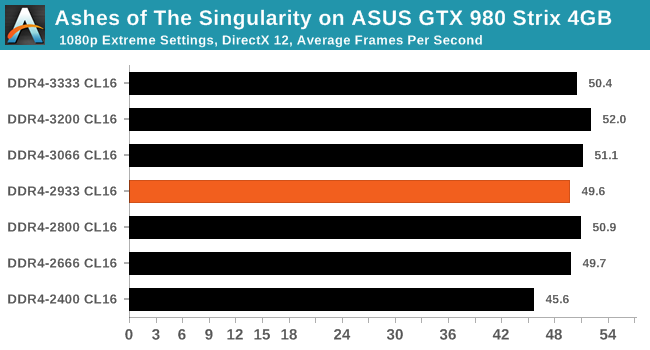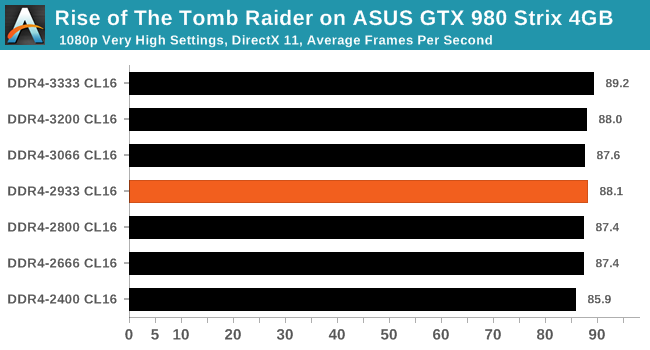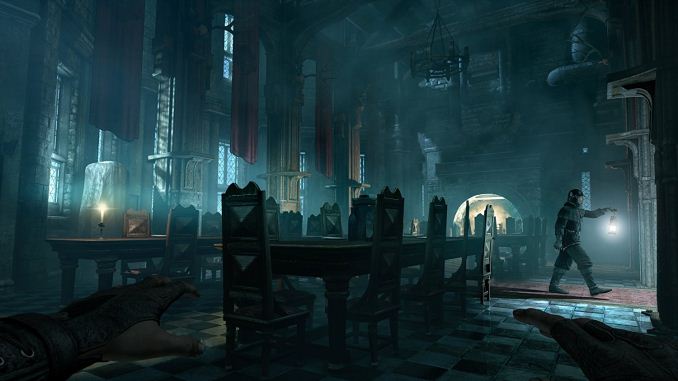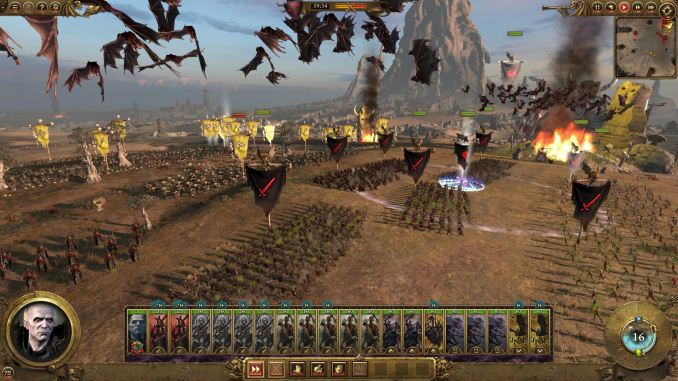Memory Scaling on Ryzen 7 with Team Group's Night Hawk RGB
by Ian Cutress & Gavin Bonshor on September 27, 2017 11:05 AM ESTGaming Performance
Ashes of the Singularity (DX12)
Seen as the holy child of DX12, Ashes of the Singularity (AoTS, or just Ashes) has been the first title to actively go and explore as many of the DX12 features as it possibly can. Stardock, the developer behind the Nitrous engine which powers the game, has ensured that the real-time strategy title takes advantage of multiple cores and multiple graphics cards, in as many configurations as possible.

Performance with Ashes over our different memory settings was varied at best. The DDR4-2400 value can certainly be characterized as the lowest number near to ~45-46 FPS, while everything else is rounded to 50 FPS or above. Depending on the configuration, this could be an 8-10% difference in frame rates by not selecting the worst memory.
Rise Of The Tomb Raider (DX12)
One of the newest games in the gaming benchmark suite is Rise of the Tomb Raider (RoTR), developed by Crystal Dynamics, and the sequel to the popular Tomb Raider which was loved for its automated benchmark mode. But don’t let that fool you: the benchmark mode in RoTR is very much different this time around.
Visually, the previous Tomb Raider pushed realism to the limits with features such as TressFX, and the new RoTR goes one stage further when it comes to graphics fidelity. This leads to an interesting set of requirements in hardware: some sections of the game are typically GPU limited, whereas others with a lot of long-range physics can be CPU limited, depending on how the driver can translate the DirectX 12 workload.

We encountered insignificant performance differences in RoTR on the GTX 980. The 3.3 FPS increase at average framerates from top to bottom does not exactly justify the price cost between DDR4-2400 and DDR4-3333 when using a GTX 980 - not in this particular game at least.
Thief
Thief has been a long-standing title in the hearts of PC gamers since the introduction of the very first iteration back in 1998 (Thief: The Dark Project). Thief is the latest reboot in the long-standing series and renowned publisher Square Enix took over the task from where Eidos Interactive left off back in 2004. The game itself uses the UE3 engine and is known for optimised and improved destructible environments, large crowd simulation and soft body dynamics.

For Thief, there are some small gains to be had from moving through from DDR4-2400 to DDR4-2933, around 5% or so, however after this the performance levels out.
Total War: WARHAMMER
Not only is the Total War franchise one of the most popular real time tactical strategy titles of all time, but Sega has delved into multiple worlds such as the Roman Empire, the Napoleonic era, and even Attila the Hun. More recently the franchise has tackeld the popular WARHAMMER series. The developers Creative Assembly have integrated DX12 into their latest RTS battle title, it aims to take benefits that DX12 can provide. The game itself can come across as very CPU intensive, and is capable of pushing any top end system to their limits.

Even though Total War: WARHAMMER is very CPU performance focused benchmark, memory had barely any effect on the results.














65 Comments
View All Comments
notashill - Wednesday, September 27, 2017 - link
There's a new AGESA 1.0.0.6b but AMD has said very little about what changed in it.JocPro - Wednesday, September 27, 2017 - link
According to page 3, how come 2933 MT/s (67 MT/s apart of the rated bandwidth) is *nearest* to the kit's rating, if 3066 MT/s is just 66 MT/s apart of the kit's rating?DanNeely - Wednesday, September 27, 2017 - link
Because rounding. They're 2933.33333.... and 3066.66666..... Both are 66.6666.... off and XMP (which is how the DIMM maker specifies what to do) rounds to the lower one not the higher one.DanNeely - Wednesday, September 27, 2017 - link
In theory anyway. In practice manufacturing variance (not sure if CPU or mobo) means the step size won't be exactly 133.3333.... but rather slightly higher or lower than that value.FreckledTrout - Wednesday, September 27, 2017 - link
For those prices I would rather pick up G Skill Flare x running at 3200Mhz and CAS14 ($190 on newegg).qlum - Wednesday, September 27, 2017 - link
While it is an older lgame it would have been interesting to see fallout 4 included here as it is notorious for its memory scalingOutlander_04 - Wednesday, September 27, 2017 - link
I am curious about the use of such an old graphics card. Surely an nVidia 10xx card, or RX vega was availableLolimaster - Wednesday, September 27, 2017 - link
Come one, people are running 3200 CL14 on Ryzen for many months, why test with a puny CL16.This should also include DDR4 3600-4000 with many brands.
Nagorak - Thursday, September 28, 2017 - link
Few have even managed to get 3600 MHz stable with Ryzen, let alone anything more than that. Even 3466 isn't a given for many boards/processors.CheapSushi - Thursday, September 28, 2017 - link
I think it is time for RAM to go the QDR route (quad data rate) instead for upcoming DDR5. It's already proven and workable in SRAM and GDDR5X (it's QDR despite the name. This would be a MUCH more significant improvement in latency and I/O than the paltry MHz bump DDR5 will do. I think AMD's Zen architecture would benefit and go even further with QDR for next gen.Image of QDR vs DDR: https://upload.wikimedia.org/wikipedia/commons/thu...
Image of QDR vs DDR: http://image.slideserve.com/1303208/qdr-class-vs-d...